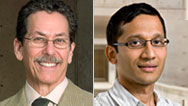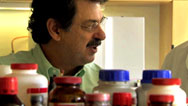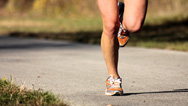Marathon Mouse
- Posted 07.14.09
- NOVA scienceNOW
(This video is no longer available for streaming.) Ron Evans at the Salk Institute says that his lab's genetically modified mice can "run the pants off" their control counterparts. Studying these marathon mice helped his team develop drugs that increase muscle mass and endurance. Such "exercise in a pill" could aid kids with muscular dystrophy, elderly people who are bedridden, and others suffering from muscle disorders. But it also poses the risk of abuse by athletes looking for a leg up.
Transcript
Marathon Mouse
PBS Airdate: July 14, 2009
NEIL DeGRASSE TYSON (Exercising): Everybody knows exercise is good for you: it's great for your heart, good way to stay trim. Some people just love doing it.
(Sitting): But for others, it's just too hard. There's all that trouble, all that sweat.
(Exercising): Then, of course, there are people who can't exercise, because of illness or injury.
Correspondent Ziya Tong met some researchers who have discovered a drug that may someday allow those people to get the benefits of exercise without having to do the work.
ZIYA TONG: When I watch something like the Boston Marathon, I'm blown away. These people are like Energizer Bunnies®: they keep going and going. And they're so lean!
How do they do it?
They'll all say, "By training." But what if you could skip all that? What if there were a drug that could miraculously give even the laziest slob a lean, buff bod, and turn them into an endurance athlete? It sounds like the ultimate couch potato fantasy.
Well, it's no fantasy to this guy. Ron Evans, from the Salk Institute, figured out the secret formula and gave the magic potion to a mouse. And just like that, a couch potato mouse was transformed into a real marathoner.
It all started with Evans's fascination with endurance. Only some animals have it. Horses have endurance and so do migratory birds, but our closest relatives, all the other primates, don't.
RON EVANS: In fact, humans are the only primates that have endurance. You don't see gorillas going on marathon runs, and the other primates aren't really designed for long distance running. Humans are designed to be good runners if we want to be good runners.
ZIYA TONG: Glen Mays is a good runner.
GLEN MAYS: I've been running for a very long time. I started when I was a young kid, and I had, kind of, a knack for it.
ZIYA TONG: Glen has such a knack, he won the Little Rock, Arkansas, marathon.
Are you tired yet?
GLEN MAYS: No, not yet.
ZIYA TONG: And me? Not so much knack.
Why don't you just go ahead, and I'll catch up with you later.
Of course, Glen works much harder than I do.
GLEN MAYS: You spend a lot of time just getting in the miles and doing long runs and being on your feet for 90 minutes, two hours, two and a half hours.
ZIYA TONG: And all that effort has changed Glen's muscles.
There are two main kinds of muscle. Folks like this build up the bulk with what's called fast-twitch muscle. It contracts fast and strong, and gets its energy from a particular kind of fuel source: sugar.
RON EVANS: Most muscle likes to burn sugar, so power muscle burns sugar.
ZIYA TONG: But if you could look inside the body of someone with endurance, say, inside the legs of Glen Mays, you'd see slow-twitch muscles. These can keep going for much, much longer because the fuel they burn is something much higher-octane than sugar.
RON EVANS: Endurance muscle burns fat.
ZIYA TONG: When it comes to fat, a little bit provides a lot of energy. Most people can train their bodies to burn more fat, but they've got to work at it.
RON EVANS: Exercise is what usually promotes that fat-burning, but we don't get enough exercise. So we wanted to see if we could actually trigger the process, even in absence of exercise.
ZIYA TONG: So Ron Evans went on the hunt for a way to rev up the fat-burning in a muscle without making it exercise.
He homed in on a key gene, one that can turn on lots of other genes.
RON EVANS: We're looking at a master regulator. It is sort of a genetic switch. If you're able to switch it on, you will activate a network of genes that allows you to burn fat.
ZIYA TONG: Evans figured out how to turn on this fat-burning genetic switch inside a mouse embryo, so it would work in overdrive. And then he watched the genetically-engineered mouse grow up. It was definitely more svelte.
RON EVANS: And, indeed, the mouse that was generated from that does burn more fat. It's slightly thinner, and we liked the way in which the mouse was looking.
ZIYA TONG: But this mouse was a lot more than good looking.
RON EVANS: If you put it on a treadmill, it can run the pants off of any other mouse. And so while the other one had been exhausted, thrown back off the treadmill, this mouse was running for another hour. And this mouse, we call the marathon mouse.
ZIYA TONG: By manipulating just one genetic switch in the embryo, Evans created a mouse with fantastic endurance. How's that possible?
It turns out, the switch Evans turned on set off a chain reaction that directed the mouse to make more slow-twitch muscle. Slow-twitch muscle is especially packed with things called mitochondria. Mitochondria are little factories inside our cells that turn sugar and fat into energy. And in the marathon mouse, the mitochondria were burning more fat than usual.
The mouse's muscles and metabolism were completely transformed, as if this little guy had been exercising his butt off, all because Evans turned on one little switch in the mouse embryo.
A mouse that could run almost twice as far as an ordinary mouse made science headlines and had very interesting implications for people. After all, who wouldn't want the ability to run that extra mile? The problem was, these mice were programmed, as embryos, to be superstars, and we don't do that to human beings, at least not yet. So Ron Evans started searching for a drug that could activate that same marathon gene. But as he soon found out, it's not that easy.
When Evans tried to use a drug to turn on the fat-burning gene in an already-grown-up mouse, it didn't really work. He got a mouse that didn't run any better than average.
So Evans took a closer look at what happens inside our muscle cells whenever we give them a workout.
ROGER FIELDING (Tufts University School of Medicine): As you become more and more trained, the muscle actually starts making more mitochondria and also making them larger, so that they can actually process and break down more fuels for energy.
ZIYA TONG: So how does exercise tell our muscles to make more mitochondria?
Evans saw that, during exercise, as energy gets consumed, certain chemicals build up in the muscle cells and trigger the cell's molecular fuel gauges. When energy gets too low, they'll signal the cell to make more mitochondria and pump out more energy.
RON EVANS: It's like the fuel gauge: we are getting on to low, we are getting near empty, let's get the gas back in the tank.
ZIYA TONG: Evans decided to try a drug called AICAR that he believed would, in effect, break the fuel gauge, tricking the muscle into thinking it was running on empty, even when it wasn't running at all.
So Evans got together some mice and didn't exercise them one bit.
RON EVANS: Completely couch potato mice, all watching T.V., none of them getting any exercise, and one of them was getting the AICAR drug.
ZIYA TONG: AICAR was injected into the mouse's bloodstream, five days a week, for a month, and when this couch potato mouse got on the treadmill, the results were amazing.
RON EVANS: That turned into a spectacular result. The ones that received AICAR were able to run approximately 44 percent longer distance.
ZIYA TONG: In fact, this drug-enhanced couch potato mouse ran nearly a mile. That's almost like running a whole marathon for you or me.
And when Evans took a look inside the mouse's muscle cells, the difference the drug made was striking.
Look at the normal mouse's cells; the mitochondria show up as dark spots. But look at the mouse that took AICAR; tons more mitochondria.
RON EVANS: This looks like the muscle of an athlete.
ZIYA TONG: This one drug managed to break the fuel gauge and trick the muscle into turning on its endurance genes, pushing the muscle into overdrive.
RON EVANS: It's remarkable that the benefit of exercise alone and the benefit of the drug – almost exact.
ZIYA TONG: That's right. In totally sedentary mice, Evans's drug produced results identical to regular exercise.
At this point, you might be wondering, "Where can I get some?" Well, it's a bit too soon for us humans to be taking this. Though the mice didn't develop side effects, nobody really knows how it will affect people.
But if it could be used safely, doctors are hopeful it could be a valuable therapy for people who can't exercise, especially for the old and frail, who can lose muscle at an alarming rate.
WILLIAM J. EVANS (University of Arkansas for Medical Sciences): Ten days of bed rest is equivalent to about 15 years of aging. And so, oftentimes, we see someone who is fully functional go into a hospital and five or six days later they come out of the hospital hardly able to walk. A drug like this, if it helps to restore function in older people, it may make it a lot easier for them to become active, and that would be fantastic.
ZIYA TONG: Ron Evans would love to see people benefit from what could be exercise in a pill, but one major concern is how this drug might be abused, especially by athletes.
RON EVANS: Athletes have a very low threshold for looking at performance-enhancing drugs, and their real concern is not about the drug, it's whether it can be detected.
ZIYA TONG: Evans has developed a test to trace AICAR in the bloodstream, to discourage doping. But even if AICAR gets out there, Glen Mays says he's one athlete who won't be taking it.
Well, if there was a drug that, perhaps, you could take that would allow you to run further, would you take it?
GLEN MAYS: I don't think I would. I don't think I would. For me, the interest and the challenge is in seeing what I can accomplish through my training. That's what keeps you motivated, and a big part of distance running is staying motivated to get out there every day and do the training.
ZIYA TONG: He's going to stick with the old-fashioned way of improving his endurance. After all, that's the one way we know definitely works. Maybe we all should try it sometime.
On Screen Text: Know what the derivation of the word "muscle" is? "Muscle, noun, origin: French, from Latin musculus diminutive of 'mouse.'" Yes, "muscle" comes from the Latin-based word "musculus," meaning "little mouse."
Why?
"Origin: So called because the shape and movement of some muscles (notably biceps) were thought to resemble mice moving beneath the skin."
Credits
Marathon Mouse
- Edited by
- Steve Audette
- Produced and Directed by
- Julia Cort and Dean Irwin
- Written by
- Julia Cort
NOVA scienceNOW
- Executive Producer
- Samuel Fine
- Executive Editor
- Neil deGrasse Tyson
- Senior Series Producer
- Vincent Liota
- Senior Producer
- Julia Cort
- Supervising Producers
- Stephen Sweigart
Joey David Jovanovich - Senior Editor and Colorist
- David Chmura
- Online Editor
- Laura Raimondo
- Senior Researcher
- Sharon Kay
- Associate Producer
- Fran Laks
- Assistant Editors
- Tung-Jen (Sunny) Chiang
Aleksandar Nedeljkovic - Graphic Design
- Brian Edgerton
- Compositor & Animator
- Yunsik Noh
- Music
- Rob Morsberger
- Sound Mix
- Bill Cavanaugh, RazorMix, Inc.
- Assistant to Neil deGrasse Tyson
- Elizabeth Stachow
- NOVA scienceNOW Series Animation
- Edgeworx
- Additional Producing for Northern Lights segment
- Anna Lee Strachan
- Associate Producers
- Molly Jacobs
Jonathan Loewald
Laura Willcox - Camera
-
John Chater
Austin de Besche
Brian Dowley
Anthony Forma
Joseph Friedman - Sound Recordists
- Ray Day
Nano Fernandez
Lee Frank
Terry Hoffman
Dave Settlemoir
- Animation
- Anthony Kraus
Sputnik Animation
James LaPlante
Elaine Lee - Production Managers for Franklin Chang-Díaz segment
- Felipe Cordero Ferní¡ndez Harold Calderon Vargas
- Archival Material
- Aldemar A. Acevedo
Agence France-Presse
Artbeats
BBC
Boston Athletic Department
Blue Entertainment Sports Television
Getty Images
Getty
Footage courtesy of the Indiana State Museum and Historic sites
ITN
Jan Karel Lameer
NASA
NASA/courtesy of nasaimages.org
Courtesy NASA Johnson Space Center Media Resource Center
Photos by George Poinar
Richard Sage - Special Thanks
- Peggy M. Chang
Aleksander Chernucho
Peter Daszak
Danielle Dee
Benny Garcia
Museum of Science and Industry
NASA Johnson Space Center Media Resource Center
Edgar A. Silva Loí¡iciga – Teletica 7, Costa Rica
Mario Valenzuela
Peter Weina - Neil deGrasse Tyson
- is director of the Hayden Planetarium in the Rose Center for Earth and Space at the American Museum of Natural History.
- NOVA Series Graphics
- yU + co.
- NOVA Theme Music
- Walter Werzowa
John Luker
Musikvergnuegen, Inc. - Additional NOVA Theme Music
- Ray Loring
Rob Morsberger - Post Production Online Editor
- Spencer Gentry
- Closed Captioning
- The Caption Center
- NOVA Administrator
- Mykim Dang
- Publicity
- Carole McFall
Eileen Campion
Victoria Louie
Karinna Sjo-Gaber
Karen Laverty - Marketing
- Steve Sears
- Researcher
- Kate Becker
- Senior Researcher
- Gaia Remerowski
- Production Coordinator
- Linda Callahan
- Paralegal
- Sarah Erlandson
- Talent Relations
- Scott Kardel, Esq.
Janice Flood - Legal Counsel
- Susan Rosen
- Production Assistant
- Ryan Murdock
- Post Production Assistant
- Darcy Forlenza
- Associate Producer, Post Production
- Patrick Carey
- Post Production Supervisor
- Regina O'Toole
- Post Production Editors
- Rebecca Nieto
Jason York - Post Production Manager
- Nathan Gunner
- Compliance Manager
- Linzy Emery
- Development Producer
- Pamela Rosenstein
- Business Manager
- Joseph P. Tracy
- Senior Producer and Project Director
- Lisa Mirowitz
- Coordinating Producer
- Laurie Cahalane
- Senior Science Editor
- Evan Hadingham
- Senior Series Producer
- Melanie Wallace
- Managing Director
- Alan Ritsko
- Senior Executive Producer
- Paula S. Apsell
This material is based upon work supported by the National Science Foundation under Grant No. 0638931. Any opinions, findings, and conclusions or recommendations expressed in this material are those of the author(s) and do not necessarily reflect the views of the National Science Foundation.
NOVA scienceNOW is a trademark of the WGBH Educational Foundation
NOVA scienceNOW is produced for WGBH/Boston by NOVA
© 2009 WGBH Educational Foundation
All rights reserved
- Image credit: (mice illustration) © WGBH Educational Foundation
Participants
- Ron Evans
- Salk Institute www.salk.edu/faculty/evans.html
- William Evans
- University of Arkansas for Medical Sciences
- Roger Fielding
- Tufts University School of Medicine www.hnrc.tufts.edu/1217253305306/HNRCA-Page-hnrca2ws_1192109688884.html
- Ziya Tong
- Correspondent
Related Links
-

Discovering Exercise in a Pill
Try our mouse-racing experiments to learn how drugs that mimic exercise were discovered and how they work.
-

Marathon Mouse: Expert Q&A
Ron Evans and Vihang Narkar of the Salk Institute answer questions about "exercise in a pill," burning fat, and more.
-

Aiding Aging Muscles
See how "exercise in a pill" could one day help the elderly and the bedridden.
-

In Sports, Focus Makes Perfect
Scientists are discovering surprising contradictions about the complex relationship between athletes' minds and bodies.



